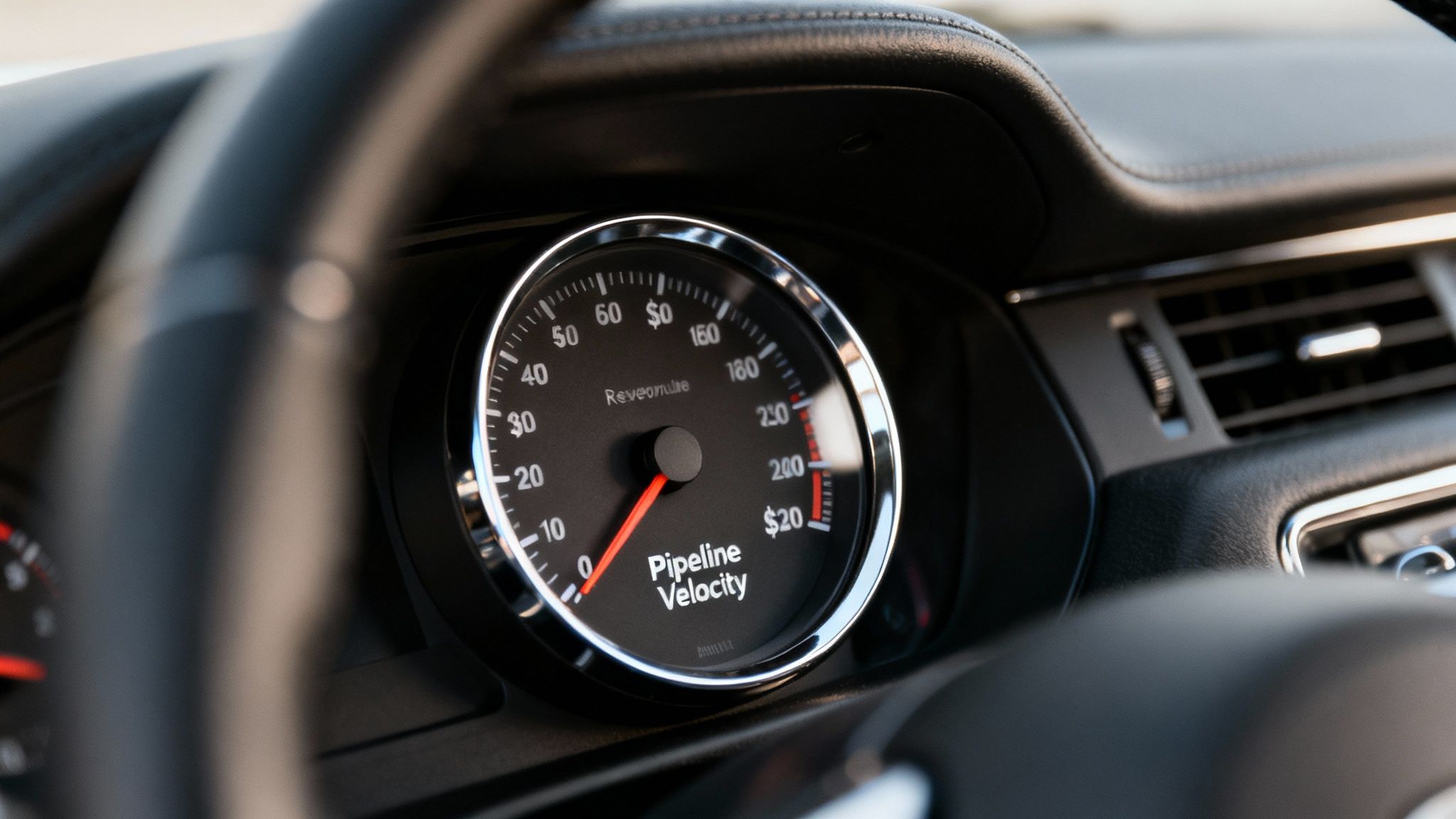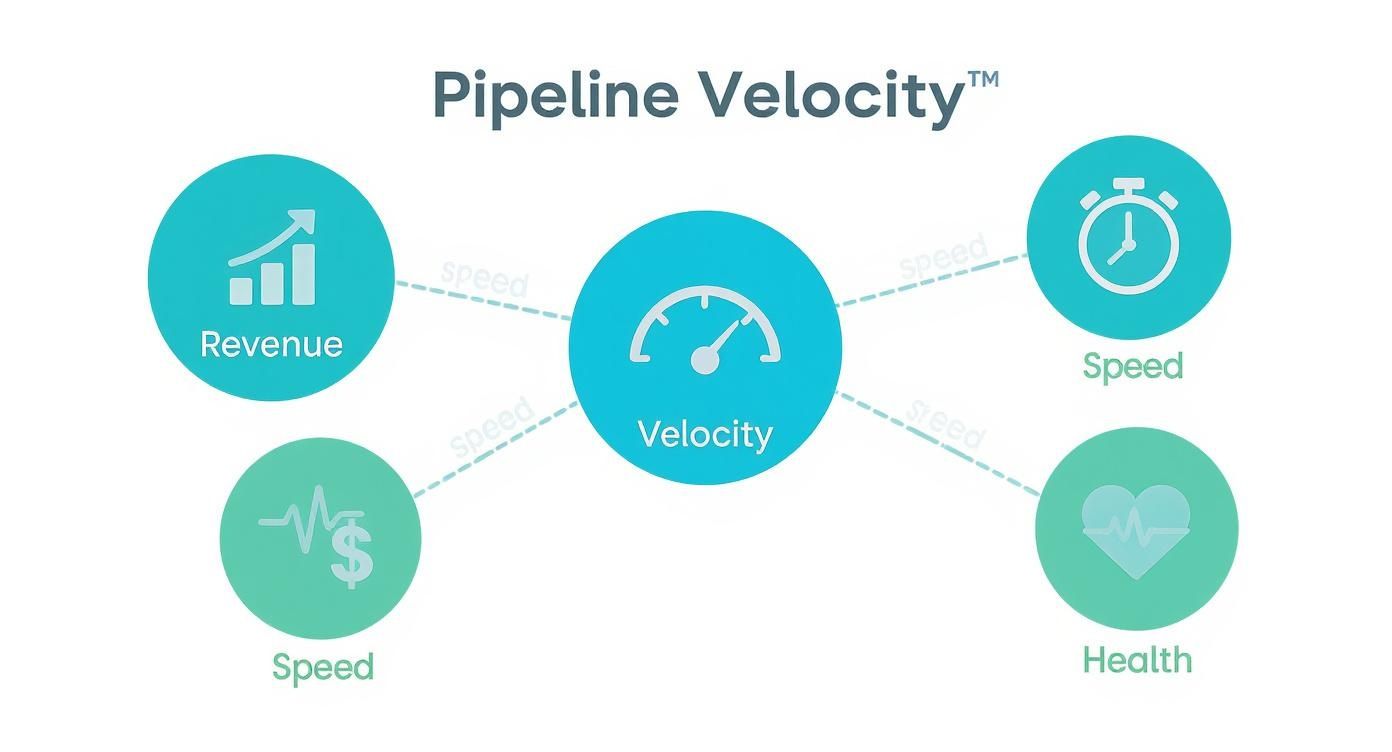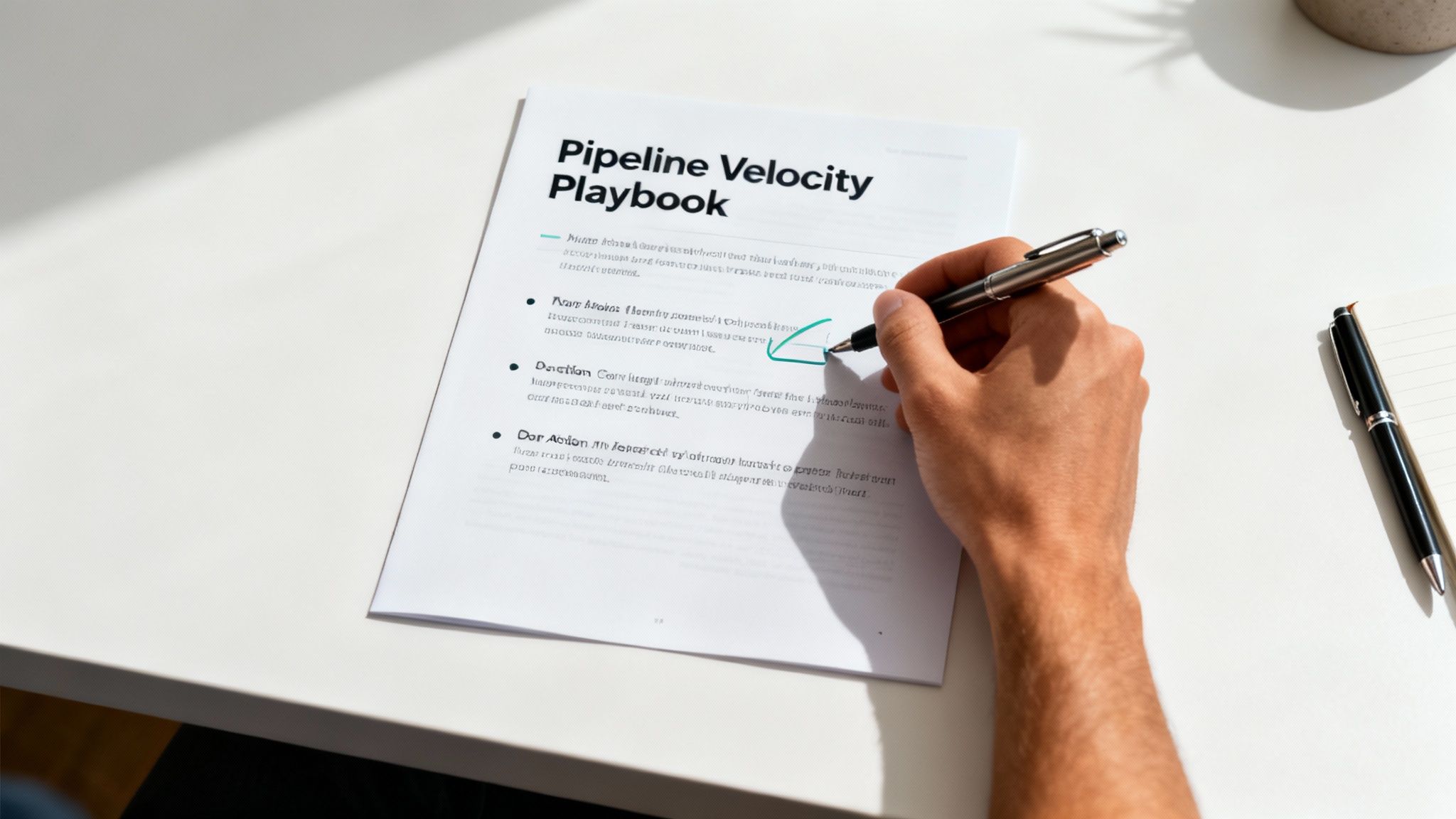Mastering the B2B Sales Funnel for Predictable Growth
A practical guide to the B2B sales funnel. Learn to build, measure, and optimize your funnel with proven strategies for converting leads into...
Unlock predictable revenue by mastering pipeline velocity. Learn the formula, key levers, and proven strategies to accelerate your sales cycle and grow faster.
TL;DR: Pipeline velocity is the speedometer for your sales engine, telling you how fast you're generating revenue. By understanding and improving its four key drivers—opportunities, deal size, win rate, and sales cycle length—you can pinpoint bottlenecks, accelerate growth, and build a more predictable revenue stream.
Think of pipeline velocity as the speedometer for your sales engine. It’s a single metric that tells you how fast you’re actually generating revenue. Get a handle on it, and you can pinpoint exactly where your sales process is slow, stuck, or just plain broken. It's the key to accelerating growth and building a revenue stream you can actually predict.

So what is pipeline velocity, really? It’s a powerful metric that shows how quickly deals are moving through your sales pipeline and turning into actual, spendable revenue.
It's not just one thing, though. It’s a combination of four crucial factors:
A high velocity is a great sign—it means you have a healthy, efficient sales process humming along. On the flip side, a low velocity can be a red flag, signaling bottlenecks or weaknesses that need your immediate attention. By tracking it, you can stop guessing and start knowing, making smarter decisions that have a direct impact on your bottom line.
What is a simple analogy for pipeline velocity?
Imagine your sales pipeline is a literal pipe with water flowing through it.
Higher velocity means more water (revenue) gets through the pipe, faster.
Why is pipeline velocity a critical metric?
Because it's one of the few metrics that gives you a holistic, 360-degree view of your sales health. Instead of just looking at win rates or deal size in isolation, velocity weaves them all together. It shows you how effectively your entire sales machine generates revenue over time.
How often should I measure pipeline velocity?
For most businesses, tracking pipeline velocity on a monthly or quarterly basis hits the sweet spot. This gives you enough data to spot meaningful trends and lets your team implement changes and measure their impact. It keeps you from overreacting to small, week-to-week blips.
Think of your sales process like a factory assembly line. Its job isn't just to crank out a finished product—a closed deal—but to do it efficiently and predictably. Pipeline velocity is the metric that tells you just how fast and healthy that assembly line is running.
It’s way more than a buzzword; it's the speedometer for your sales engine. It measures the speed at which deals move through your pipeline and actually turn into revenue. A high velocity means you're bringing in more money in less time. A low velocity is a clear signal that something, somewhere, is gumming up the works.
Unlike other metrics that only look at one piece of the puzzle, pipeline velocity gives you the full picture. It combines four key elements of your sales performance into a single, powerful number that reveals the true health of your revenue engine. This makes it an indispensable diagnostic tool for any sales team.
Tracking pipeline velocity is critical because it pulls you out of the world of guesswork and into data-driven decision-making. It tells you whether your reps' strategies are actually working and, more importantly, shines a spotlight on the specific friction points that are stalling your deals.
Knowing this number gives you actionable insights. You can see precisely where the bottlenecks are forming, which lets you make smart, strategic adjustments. For example, you might discover that a slowdown isn't from a lack of leads but from a negotiation stage that drags on forever.
Pipeline velocity is a leading indicator of future revenue. While trailing indicators like quarterly sales tell you what happened in the past, velocity helps you forecast what’s likely to happen next, giving you the power to proactively manage your sales outcomes.
This allows sales leaders to set more realistic expectations and build accurate revenue forecasts. When you truly understand how quickly your team can convert opportunities into cash, you can allocate resources more effectively and build a predictable growth model that you can actually count on.
One of the biggest benefits of measuring pipeline velocity is its uncanny ability to expose hidden problems. A pipeline that looks healthy on the surface—stuffed with plenty of opportunities—can easily hide underlying issues that a simple deal count would never catch.
For instance, consider these scenarios:
By breaking down the components of pipeline velocity, you can isolate the exact lever you need to pull. This focused approach is far more effective than just shouting "sell more!" without understanding the root cause of the problem. It transforms how you manage your team, shifting the focus from just activity to efficient, revenue-generating outcomes.
To really get a handle on pipeline velocity, you have to break it down into its core components. Think of it like a car engine. Pushing the gas pedal isn't the only way to go faster; you also need the right fuel mix, efficient combustion, and minimal friction. Pipeline velocity works the same way—it's controlled by four distinct "levers" you can pull to accelerate revenue.
Each lever represents a critical part of your sales process. Understanding how they work together is the first step toward making strategic adjustments that actually move the needle. When you know which lever to pull and when, you gain precise control over your entire revenue engine.
This infographic breaks down how pipeline velocity connects the concepts of revenue, speed, and overall sales health.

As you can see, velocity isn't just one thing. It's the dynamic interplay between how much money is in play, how fast it's moving, and the underlying health of your sales process.
The whole concept of pipeline velocity boils down to a single, powerful formula. This calculation is a vital metric for understanding how effectively your team converts leads into customers because it balances quantity, quality, and speed all at once.
Pipeline Velocity = (Number of Opportunities × Average Deal Size × Win Rate) ÷ Length of Sales Cycle
This formula gives you a dollar amount per day (or month, or quarter), showing the value moving through your pipeline over that period. Let's break down each of these four levers.
This is the "how many" part of the equation and the most straightforward lever. It’s the total number of qualified leads in your sales pipeline during a specific timeframe. More opportunities mean a wider pipeline, which naturally creates more potential for revenue.
But the key word here is qualified. Filling your pipeline with junk leads that will never close is a surefire way to waste time and resources. A healthy pipeline isn't just full; it’s full of opportunities that have a realistic shot at becoming customers.
Next up is the "how much" lever. This metric tracks the average revenue value of each closed-won deal. It’s a direct measure of the quality and value of the opportunities your team is pursuing.
Increasing your average deal size is one of the most efficient ways to boost pipeline velocity. You can close the same number of deals but generate significantly more revenue if each one is worth more. Think of it as increasing the water pressure in your pipeline—the same flow delivers more volume.
This often involves strategic tweaks to pricing, packaging, and sales tactics. For a deeper look into how these elements work together, you can check out our guide on RevOps best practices.
This is your team's batting average—the "what percentage" lever. Your win rate (or conversion rate) is the percentage of qualified opportunities that your team successfully closes. It’s a direct reflection of your sales team's effectiveness and the strength of your entire sales process.
A high win rate shows your team is skilled at demonstrating value, handling objections, and guiding prospects to a decision. Even a small improvement here, say from 20% to 25%, can have a massive impact on your overall velocity because it compounds the value of every single opportunity in your pipeline.
Finally, we have the "how fast" lever. This measures the average time it takes for an opportunity to move from initial contact to a closed deal, usually in days. A shorter sales cycle means you're converting opportunities into revenue more quickly.
Cutting down your sales cycle length is like reducing friction in your pipeline. The faster you can close deals, the faster you can move on to the next one, allowing your team to work through more opportunities in the same amount of time.
This involves hunting down and eliminating bottlenecks. Where do deals get stuck? Is it during legal review, pricing negotiations, or security assessments? Streamlining these stages can dramatically shorten your cycle and accelerate your pipeline velocity.
Alright, you've got the four levers that drive your revenue engine down. Now it's time to get our hands dirty and put the formula to work. Calculating your pipeline velocity is where abstract metrics become a real, tangible number—one that shows you exactly how much revenue your sales process is generating every single day.
To make this crystal clear, we'll walk through two very different business scenarios. This will show you how the variables play off each other depending on the sales model and what the final velocity number actually means for each company.
First up, let’s look at "SaaS Co." They sell a software subscription with a fairly short, transactional sales cycle. Their whole model is built around generating a ton of leads and converting them fast.
Here are their key metrics from the last quarter (90 days):
Now, let's plug those numbers into the pipeline velocity formula:
(200 Opportunities × $5,000 Deal Size × 25% Win Rate) / 30 Days
Here’s the breakdown:
The math shows that SaaS Co. is effectively generating $8,333 in new revenue every single day. This number is their baseline. Any strategic changes they make—tweaking their pricing, improving their sales script—can now be measured against this daily velocity to see if they’re actually speeding up the engine.
Next, let's analyze "Enterprise Solutions Inc." This company sells complex, big-ticket solutions to large corporations. Their sales process is much longer and involves a ton of stakeholders, but each deal is a monster.
Here are their numbers over the last year (365 days):
Let’s apply the formula to their business:
(50 Opportunities × $250,000 Deal Size × 15% Win Rate) / 180 Days
And the calculation:
Even with fewer opportunities, a lower win rate, and a sales cycle that's six times longer, Enterprise Solutions Inc. has a higher pipeline velocity ($10,416 per day) than SaaS Co. This is the perfect illustration that a smaller number of high-value deals can absolutely generate more daily revenue than a high volume of smaller transactions.
To bring this to life, here’s a quick table comparing the two scenarios side-by-side.
| Metric | Scenario A (SaaS Co.) | Scenario B (Enterprise Solution) |
|---|---|---|
| Opportunities | 200 | 50 |
| Average Deal Size | $5,000 | $250,000 |
| Win Rate | 25% | 15% |
| Sales Cycle Length | 30 Days | 180 Days |
| Pipeline Velocity | $8,333 / day | $10,416 / day |
This comparison shows there's no single "right" way to build a powerful revenue engine. While one company focuses on quantity and speed, the other prioritizes deal size—and both can be successful.
Accuracy is everything. A flawed calculation leads to flawed decisions. As you figure out your own pipeline velocity, watch out for these common traps:
Knowing your pipeline velocity is step one. Actually improving it? That’s where the real growth kicks in. Once you have that baseline number, you can start strategically pulling the four levers we've talked about to get your revenue engine humming.
The goal isn't just to make a number go up for the sake of it. It's about making targeted improvements that build a faster, more efficient, and far more predictable sales process. This section is your playbook for making that happen.

Think of this as the fuel for your entire sales engine. Pumping up the volume of opportunities is a direct path to better pipeline velocity, but there's a catch: it only works if those opportunities are genuinely qualified. Flooding your pipeline with poor-fit leads will just slow everything down.
The focus here is on quality at scale. Here’s how to get there:
Closing bigger deals is one of the most efficient ways to boost velocity, period. You can keep the same win rate and sales cycle, but bring in significantly more revenue. This lever is all about wringing more value out of every single customer interaction.
Here are a few proven tactics:
Your win rate is a direct reflection of your sales team's effectiveness. Even a small bump here creates a massive ripple effect across your entire pipeline. A higher win rate means you're squeezing more revenue from the same number of opportunities, making your whole process more efficient.
To nail this crucial metric, zero in on coaching and process refinement:
The final lever is all about speed. The faster you can move a deal from "hello" to "closed-won," the more deals your team can juggle in a given period. Shortening your sales cycle comes down to one thing: finding and obliterating friction in the buying process.
Look for the stages where deals always seem to get stuck. Is it the legal review? The security sign-off? That final approval from the CFO? Once you find the bottlenecks, you can take action.
One of the most powerful ways to remove friction is through automation. By automating all the repetitive, administrative junk, you free up your reps to do what they do best: sell. To see how you can put this into practice, check out our guide on sales process automation.
Other key strategies include:
Once teams start wrapping their heads around this metric, a few practical questions always pop up. It’s totally normal. Let's walk through the most common ones so you can start applying this with confidence.
Great question. For most sales teams, checking your pipeline velocity on a monthly or quarterly basis hits the sweet spot.
This rhythm is long enough to smooth out any weird weekly blips and show you real trends, but it's short enough that you can actually do something about it. If you measure it too often, say weekly, you risk making knee-jerk reactions to incomplete data. But wait a whole year, and you might miss the chance to fix a small leak before it becomes a massive hole in your revenue plan.
Absolutely. Throwing more money at marketing to generate more opportunities is just one way to pull the lever—and it's often not the most effective one. Some of the smartest plays to boost pipeline velocity won't cost your marketing team a single dime.
Improving pipeline velocity isn’t just about spending more; it's about selling smarter. Focusing on your internal game—things like sales coaching, deal reviews, and cutting the red tape in your sales cycle—can create huge gains without touching your ad spend.
You have three other powerful levers to pull:
This is the million-dollar question, and the honest-to-goodness answer is: it completely depends on your business. There’s no magic number that works for everyone.
A high-volume SaaS company might be cruising at $5,000 per day, while a firm selling complex enterprise software could see $50,000 per day as their normal pace.
Instead of getting hung up on comparing your number to someone else's, focus on your own trends. The real goal is to figure out your baseline and then work to consistently beat it. Your "good" is simply a number that’s better than last quarter's. That's it.
Stop wasting hours on manual account research and start focusing on what matters—selling. Salesmotion is an AI-powered platform that delivers real-time account intelligence, automated executive briefs, and strategic points of view directly to your team. Empower your reps to have more meaningful, "why now" conversations and convert account signals into measurable pipeline growth. Learn how Salesmotion can accelerate your revenue engine.
A practical guide to the B2B sales funnel. Learn to build, measure, and optimize your funnel with proven strategies for converting leads into...
Discover proven B2B prospecting strategies that build pipeline and drive sales. Learn how to find high-value leads and master modern outreach.
Build a winning go to market strategy framework. This guide breaks down the core components, steps, and metrics for a successful product launch.